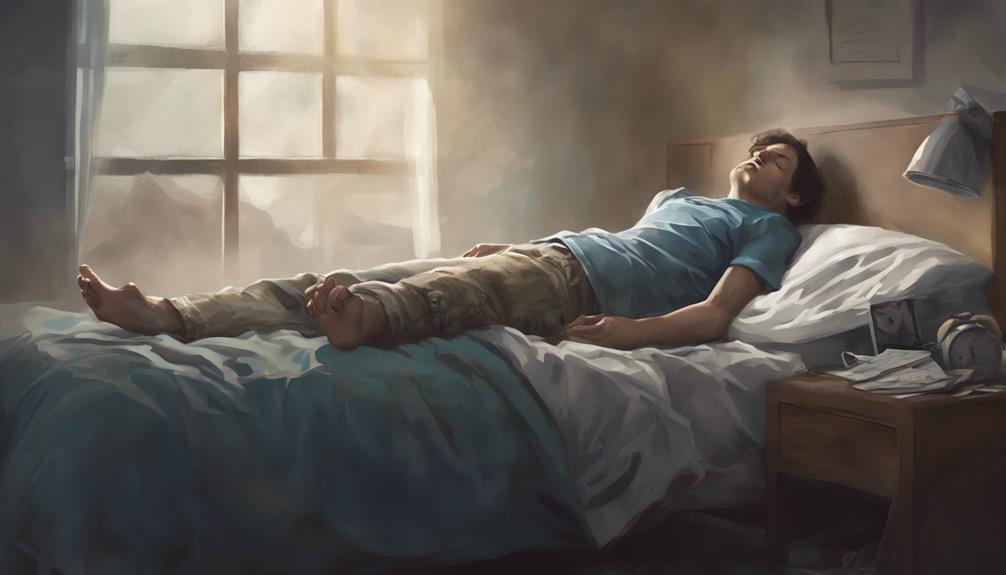Broken Wrist Syndrome Adhd Sleeping
Having ADHD feels like juggling broken pieces of glass while trying to navigate a dark room. Imagine adding a broken wrist to the mix.
The intersection of Broken Wrist Syndrome and ADHD can be a perplexing challenge, especially when it comes to sleeping. The impact on sleep quality, coping mechanisms for physical pain, managing cognitive difficulties, and finding comfortable resting positions are all essential aspects that need to be addressed.
Let's explore how these intertwined conditions affect one's ability to rest and rejuvenate, and discover strategies to navigate this complex terrain.
Key Takeaways
- Proper sleep position and mattress firmness are crucial for comfort and support.
- Managing pain and ADHD symptoms effectively is essential for quality sleep.
- Consistent bedtime routines and a conducive sleep environment aid in better rest.
- Quality sleep significantly impacts ADHD symptoms, emotional regulation, and overall well-being.
Challenges of Broken Wrist and ADHD

Dealing with both a broken wrist and ADHD poses significant challenges when trying to find a comfortable sleeping position. The symptoms of ADHD, such as restlessness and difficulty focusing, can exacerbate the discomfort experienced from a broken wrist, making it harder to settle down for sleep. The broken wrist itself adds physical pain and limitation to the equation, further complicating the situation.
With ADHD symptoms in play, the restlessness can make it challenging to stay still long enough to find a position that doesn't aggravate the broken wrist. Additionally, the need to protect the injured wrist during sleep can restrict movement options, leading to frustration and potential sleep disturbances. It becomes a delicate balance between finding a comfortable position that supports the wrist while also accommodating the restlessness that comes with ADHD.
Addressing these challenges requires a tailored approach that considers both the physical pain of the broken wrist and the behavioral aspects of ADHD. Strategies to manage ADHD symptoms and alleviate wrist pain may include using supportive braces or cushions to stabilize the wrist and implementing relaxation techniques to calm the mind before bedtime. By addressing both the physical and mental aspects of the issue, individuals with ADHD and a broken wrist can work towards improving their ability to find a comfortable sleeping position.
Impact on Sleep Quality

Impact on Sleep Quality due to broken wrist syndrome can greatly disrupt the rest and comfort of individuals with ADHD. When a broken wrist coexists with ADHD, the following impacts on sleep quality may arise:
- Discomfort and pain from the broken wrist can make it challenging to find a comfortable sleeping position, worsening existing ADHD-related sleep problems.
- Restlessness during sleep due to wrist pain can lead to decreased overall sleep duration and quality, affecting daily functioning and well-being.
- Managing both ADHD and a broken wrist may necessitate adjustments to bedtime routines and sleep environment to optimize rest and recovery.
The combination of broken wrist syndrome and ADHD presents unique challenges to achieving restful sleep. Seeking medical guidance for pain management and exploring suitable wrist support options are essential steps towards improving sleep outcomes for individuals facing this dual challenge.
Strategies for Better Sleep

Moving towards achieving better sleep for individuals with ADHD, implementing structured bedtime routines can significantly enhance sleep quality and duration. Consistent sleep schedules help regulate the body's internal clock, making it easier to fall asleep and wake up at the same time each day.
Avoiding daytime naps is important as they can disrupt the ability to fall asleep at night, especially for individuals with ADHD. Limiting caffeine intake before bedtime is essential as stimulants can exacerbate sleep disturbances in this population. Additionally, considering ADHD medication effects on sleep is important. Non-habit-forming medications like Melatonin or Clonidine can be beneficial in addressing ADHD-related sleep problems.
Individuals with ADHD often struggle with emotional dysregulation, which can impact their ability to relax and fall asleep. Creating a calm and soothing bedtime routine can help manage emotional dysregulation, promoting a more restful sleep environment.
Implementing multiple alarms for medication intake and waking up can assist individuals with ADHD in maintaining a consistent sleep schedule, ultimately improving overall sleep quality.
Coping With Physical Pain

Experiencing physical pain, particularly from a broken wrist, can greatly worsen sleep disturbances in individuals with ADHD. When coping with physical pain, especially in the context of ADHD, it's essential to contemplate tailored strategies to alleviate discomfort and improve sleep quality.
- Proper Medication: Managing pain with appropriate medications prescribed by healthcare professionals can help individuals with ADHD experience relief and enhance their ability to rest.
- Therapeutic Interventions: Therapy sessions focusing on pain management techniques tailored to ADHD symptoms can provide valuable support in addressing both physical discomfort and sleep disturbances.
- Comfortable Sleep Environment: Creating a conducive sleep environment by using pillows or supports to cushion the injured wrist can promote better rest and aid in mitigating the impact of physical pain on sleep for individuals with ADHD.
Managing Cognitive Difficulties

To effectively address cognitive challenges in individuals with ADHD, implementing structured routines and utilizing organizational tools are key strategies for enhancing cognitive function and productivity. The ADHD brain often struggles with maintaining focus, organizing tasks, and managing time effectively. Breaking down complex tasks into smaller, more manageable steps can help individuals with ADHD navigate cognitive difficulties. Tools like planners, calendars, and reminders can assist in keeping track of responsibilities and deadlines, reducing the cognitive load on the individual.
Cognitive behavioral therapy (CBT) is another effective intervention used to treat cognitive difficulties associated with ADHD. This therapeutic approach helps individuals identify and modify negative thought patterns and behaviors that may be hindering cognitive function. Additionally, maintaining a healthy lifestyle through regular exercise and a balanced diet can support cognitive function in individuals with ADHD. Seeking guidance from healthcare professionals, such as psychologists or psychiatrists, can provide personalized strategies to address cognitive challenges and improve overall cognitive performance in individuals with ADHD.
Tips for Comfortable Resting Positions

When resting with a broken wrist, it's important to elevate the wrist above heart level and use a pillow for support to maintain a neutral position.
Sleeping on the back or the unaffected side can help prevent additional pressure on the injured wrist.
Consider consulting a healthcare professional for personalized recommendations based on your specific situation.
Pillow Support Options
Utilizing a supportive pillow beneath the wrist can greatly alleviate discomfort and enhance sleep quality for individuals with a broken wrist. When selecting pillow support options, consider the following:
- Memory foam or contour pillows provide customized support, reducing pressure on the injured wrist.
- Elevating the broken wrist slightly with a pillow can aid in reducing swelling and improving circulation.
- Avoid placing direct pressure on the broken wrist while sleeping to prevent worsening pain and discomfort.
Experimenting with various pillow sizes and shapes can help identify the most comfortable and supportive sleeping position. These adjustments can greatly improve rest for individuals dealing with a broken wrist.
Bed Posture Alignment
Maintaining proper bed posture alignment plays an important role in reducing discomfort and enhancing sleep quality, especially for individuals with a broken wrist. Sleeping on your back with a pillow under your knees can help alleviate pressure on your lower back and wrists. It's advisable to avoid sleeping on your stomach as this position can put excessive strain on your wrists and worsen discomfort.
Side sleeping with a pillow between your knees can help keep your spine aligned and reduce wrist pain. For individuals with ADHD, poor bed posture alignment can lead to side effects such as increased restlessness and difficulty falling asleep. Ensuring proper alignment can contribute greatly to improving sleep quality and overall well-being.
Mattress Firmness Levels
To enhance comfort and support for individuals with broken wrist syndrome and ADHD during rest, selecting a mattress with the appropriate firmness level is essential.
- A medium-firm mattress is often recommended for a balance of support and cushioning.
- Mattresses that are too soft may cause discomfort and lack of support.
- Mattresses that are too firm can exacerbate pressure points and lead to poor sleep quality.
Consulting with healthcare professionals or mattress experts can help in finding the most suitable firmness level. Adjustable mattresses with varying firmness levels can also be beneficial for those with broken wrist syndrome and ADHD, allowing customization of sleeping positions for the most suitable comfort and support.
Importance of Quality Sleep

Quality sleep plays a crucial role in the well-being and cognitive function of individuals, especially those diagnosed with ADHD. Adequate sleep is essential for regulating mood, attention, and impulse control in people with ADHD. Poor sleep quality can worsen ADHD symptoms, leading to increased impulsivity and reduced focus. Establishing a consistent sleep routine can significantly improve symptoms and overall quality of life for individuals with ADHD.
Addressing sleep issues in this population can lead to better condition management and improved daily functioning. Prioritizing quality sleep involves creating a conducive sleep environment, following a regular sleep schedule, and practicing good sleep hygiene. By focusing on improving sleep quality, individuals with ADHD can enhance cognitive function, improve emotional regulation, and overall well-being.
Frequently Asked Questions
Is Broken Wrist Syndrome a Trait of Autism?
No, Broken Wrist Syndrome is not a characteristic of Autism. Autism spectrum symptoms differ from Broken Wrist Syndrome. Behavioral therapy and interventions are essential for managing Autism, focusing on social skills and communication development.
What Causes Broken Wrist Syndrome?
Causes of wrist injuries vary but can include falls, sports accidents, or repetitive strain. Prevention involves safety measures and proper ergonomics. Treatment may range from rest to surgery. Diagnosis requires medical evaluation. Management and recovery depend on the severity of the injury.
How Do You Help Someone Who Broke Both Wrists?
To help someone who broke both wrists, I provide recovery tips and support systems. Assisting with daily tasks, adjusting sleeping positions, and encouraging treatment adherence are vital. Emotional support and understanding are essential throughout their healing journey.
Can a Broken Wrist Make You Feel Tired?
Having a broken wrist can lead to chronic fatigue and sleep disturbances. It disrupts routines, causes pain, and limits mobility, affecting energy levels. Prioritizing self-care and seeking medical help is essential for managing both physical and mental health needs.
Conclusion
To sum up, handling the challenges of broken wrist syndrome and ADHD can greatly affect sleep quality. By implementing strategies for better sleep, managing physical pain, and addressing cognitive difficulties, individuals can enhance their overall well-being.
Remember, 'early to bed and early to rise, makes a man healthy, wealthy, and wise.' Prioritizing quality sleep is essential for peak functioning and overall health.







